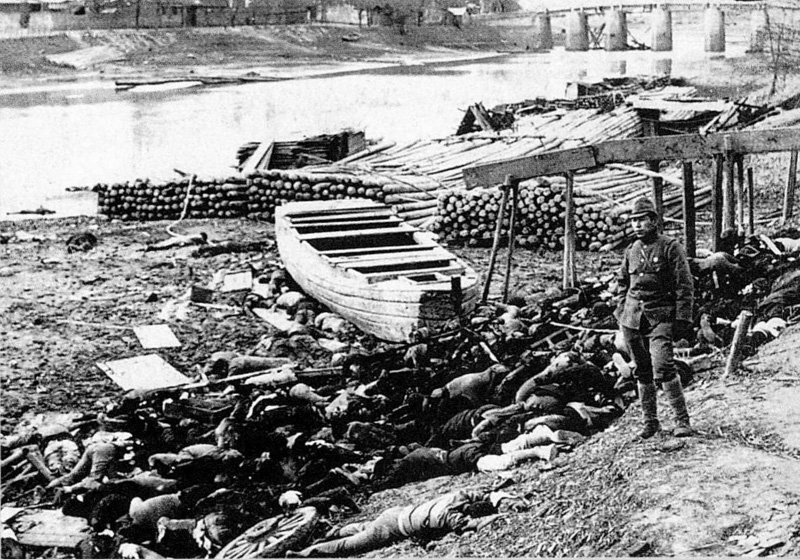|
Hisao Tani
was a lieutenant general in the Imperial Japanese Army in the Second Sino-Japanese War who was convicted of war crimes. Forces under his command committed the 1937 Nanjing Massacre. Tani was tried in the Nanjing War Crimes Tribunal and executed. Biography Early military career Tani was born to a farming family in Okayama Prefecture. He graduated from the 15th class of the Imperial Japanese Army Academy in 1903, placing 16th in his class. One of his classmates, Yasusuke Nogi, was the younger son of General Nogi Maresuke, and later died in combat during the Russo-Japanese War. Tani also saw combat during that war as a second lieutenant in the Guard's First Infantry Battalion, although his training at the academy had been in artillery. After the war, he graduated in third place from the 24th class of the Army War College in 1912. Tani later wrote an account of his experiences in the war, together with first-hand accounts of survivors, which was published under the tile . The book ... [...More Info...] [...Related Items...] OR: [Wikipedia] [Google] [Baidu] |
Okayama
is the capital city of Okayama Prefecture in the Chūgoku region of Japan. The city was founded on June 1, 1889. , the city has an estimated population of 720,841 and a population density of 910 persons per km2. The total area is . The city is the site of Kōraku-en, known as one of the top three traditional gardens in Japan, and Okayama Castle, which is ranked among the best 100 Japanese castles. The city is famous as the setting of the Japanese fable " Momotarō". Okayama joined the UNESCO Global Network of Learning Cities in 2016. History Sengoku period to Teisho period Before the Muromachi period, Okayama was one corner of a farm region and included a small castle built by the Kanemitsu. In the Sengoku period, Ukita Naoie attacked Okayama and attacked the castle for the transportation resources and extensive farmland in the region. Naoie remodeled the castle, built the old Sanyo road to the central part of the castle town, and called in craftsmen both from inside and o ... [...More Info...] [...Related Items...] OR: [Wikipedia] [Google] [Baidu] |
Nanjing Massacre
The Nanjing Massacre (, ja, 南京大虐殺, Nankin Daigyakusatsu) or the Rape of Nanjing (formerly romanized as ''Nanking'') was the mass murder of Chinese civilians in Nanjing, the capital of the Republic of China, immediately after the Battle of Nanking in the Second Sino-Japanese War, by the Imperial Japanese Army. Beginning on December 13, 1937, the massacre lasted six weeks. The perpetrators also committed other war crimes such as mass rape, looting, and arson. The massacre was one of the worst atrocities committed during World War II. The Japanese Army had pushed quickly through China after capturing Shanghai in November 1937. By early December, it was on the outskirts of Nanjing. The speed of the army's advance was likely due to commanders allowing looting and rape along the way. As the Japanese approached, the Chinese army withdrew the bulk of its forces since Nanjing was not a defensible position. The civilian government of Nanjing fled, leaving the city under ... [...More Info...] [...Related Items...] OR: [Wikipedia] [Google] [Baidu] |
World War I
World War I (28 July 1914 11 November 1918), often abbreviated as WWI, was one of the deadliest global conflicts in history. Belligerents included much of Europe, the Russian Empire, the United States, and the Ottoman Empire, with fighting occurring throughout Europe, the Middle East, Africa, the Pacific, and parts of Asia. An estimated 9 million soldiers were killed in combat, plus another 23 million wounded, while 5 million civilians died as a result of military action, hunger, and disease. Millions more died in genocides within the Ottoman Empire and in the 1918 influenza pandemic, which was exacerbated by the movement of combatants during the war. Prior to 1914, the European great powers were divided between the Triple Entente (comprising France, Russia, and Britain) and the Triple Alliance (containing Germany, Austria-Hungary, and Italy). Tensions in the Balkans came to a head on 28 June 1914, following the assassination of Archduke Franz Ferdi ... [...More Info...] [...Related Items...] OR: [Wikipedia] [Google] [Baidu] |


